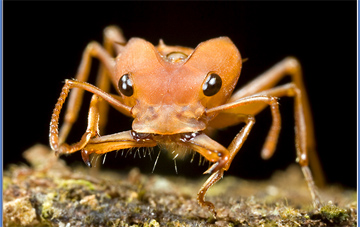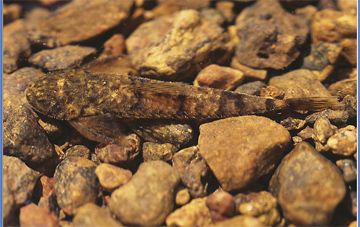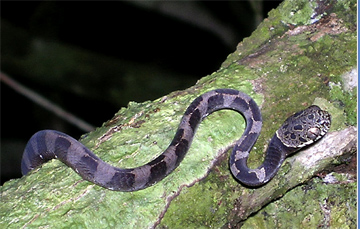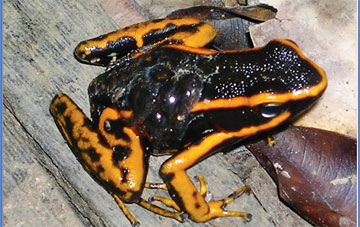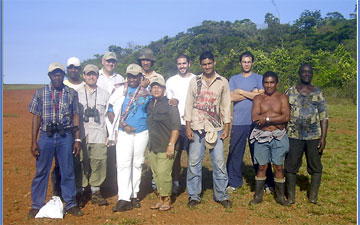Pictures of newly discovered species in Suriname rainforest
Pictures of newly discovered species in Suriname
mongabay.com
June 4, 2007
Scientists documented 467 species, including 24 species believed new to science, during a rainforest survey in eastern Suriname, South America.
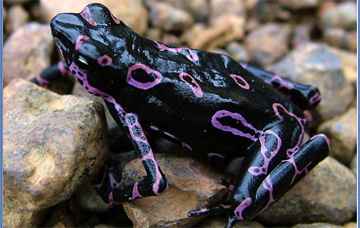
A previously unknown species of toad, possibly of the Atelopus genus, discovered during the Nassau plateau in Suriname. Atelopus toads have been particularly affected by the deadly chytrid fungus. Photo © Paul Ouboter
A rainforest canopy ant species (Daceton armigerum. Photo © Piotr Nasrecki
Dwarf suckermouth catfish (Harttiella crassicauda)) that hadn’t been spotted in 50 years until the RAP. Photo © Trond Larsen
Amazonian snail-eater snake (Dipsas indica on Lely Plateau. The species extracts snails from their shells. Photo © James I. Watling
Epipedobates trivittatus poison dart frog. Photo © James I. Watling
Eleutherodactylus chiastonotus frog. Photo © James I. Watling
CI’s Rapid Assessment Program (RAP) team for the Suriname expedition Photo © Jan Wirosentono |
The expedition, led by Conservation International (CI), was sponsored by two mining companies, BHP-Billiton Maatschappij Suriname (BMS) and Suriname Aluminium Company LLC (Suralco) (a subsidiary of Alcoa Inc.), hoping to mine the area for bauxite, the raw material used to make aluminum. Conservation International said the Rapid Assessment Survey (RAP) will help “give miners guidance on protecting unique plants and animals during potential future development,” according to a statement from the organization.
“Where current economic imperatives dictate mining, our responsibility is to ensure that operations are kept within the bounds of our benchmarks,” said CI-Suriname Executive Director Ambassador W. Udenhout.
Nevertheless, the survey, conducted during two trips to Suriname in 2005 and 2006, turned up 24 previously unknown species including a frog with fluorescent purple markings, 12 kinds of dung beetles, and a type of suckermouth catfish not seen in more than 50 years (Harttiella crassicauda). The team also noted the presence 27 endemic species.
Conservation International said the discoveries should provide impetus for protecting Suriname’s biodiverse forests. The group also noted that the findings could help scientists better understand the outbreak of a deadly fungal disease that is killing amphibians worldwide. Amphibians in Suriname do not yet show signs of the pathogen.
“Suriname has some of the Amazon’s most pristine and intact rain forest, which offers huge potential for scientific research and economic investment in carbon sequestration, as well as the sustenance it has always provided local communities,” said Leeanne Alonso, CI vice president and head of the RAP program. “Our study will be a vital component in determining how to promote economic development in Suriname while protecting the nation’s most valuable natural assets.”
Conservation International has played an integral role in the establishment of the Central Suriname Nature Reserve, a 4 million acre (1.6 million hectare) protected area in the heart of Suriname. The nonprofit has helped establish ecotourism facilities in the reserve and develop a management plan.
Suriname is one of the least densely populated countries on Earth. Only about 5 percent of the country’s population lives in its forests, which cover more than 90 percent of its territory. Still environmentalists fear that high commodity prices will increasingly put pressure on its forests. The World Bank recently ranked Suriname as among the 17 potentially richest countries in the world, given its deposits of gold, oil, diamond, and other natural resources.
MORE
CONSERVATION INTERNATIONAL: Science Is Guiding Business Decisions in Suriname, including a slide show of images from the expedition.



